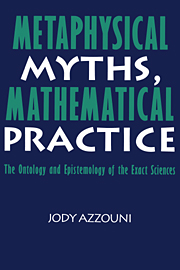PART II - THE STUFF OF MATHEMATICS: POSITS AND ALGORITHMS
Published online by Cambridge University Press: 15 December 2009
Summary
If … arbitrarily given axioms do not contradict one another with all their consequences, then they are true and the things defined by the axioms exist.
D. Hilbert to G. FregeIntroduction
I start by giving a brief characterization of what I take mathematics to be. Quite broadly, it is a collection of algorithmic systems, where any such system, in general, may have terms in it that co-refer with terms in other systems. I understand such systems to be fairly arbitrary in character; that is, there are no genuine constraints on what systems can look like. Similarly, I understand the co-referentiality allowable between the terms of different systems to be a matter entirely of stipulation.
This is not to say that mathematicians don't prefer the study of certain groups of systems to the study of others, or that they don't prefer certain stipulations regarding the co-referentiality of terms across systems to other stipulations: Of course they do, and I have quite a bit to say about how these preferences arise.
I build up this view of mathematics gradually. In Section 2, I present and modify an initial picture of what an algorithmic system is. In Sections 3 and 4,1 discuss what restraints the need to apply mathematics empirically places on any view of mathematics. I also discuss truth, for I am not a formalist, at least in one popular way that doctrine is described: The sentences of systems, although syntactically generated objects, are not to be understood as meaningless.
- Type
- Chapter
- Information
- Metaphysical Myths, Mathematical PracticeThe Ontology and Epistemology of the Exact Sciences, pp. 77 - 150Publisher: Cambridge University PressPrint publication year: 1994



